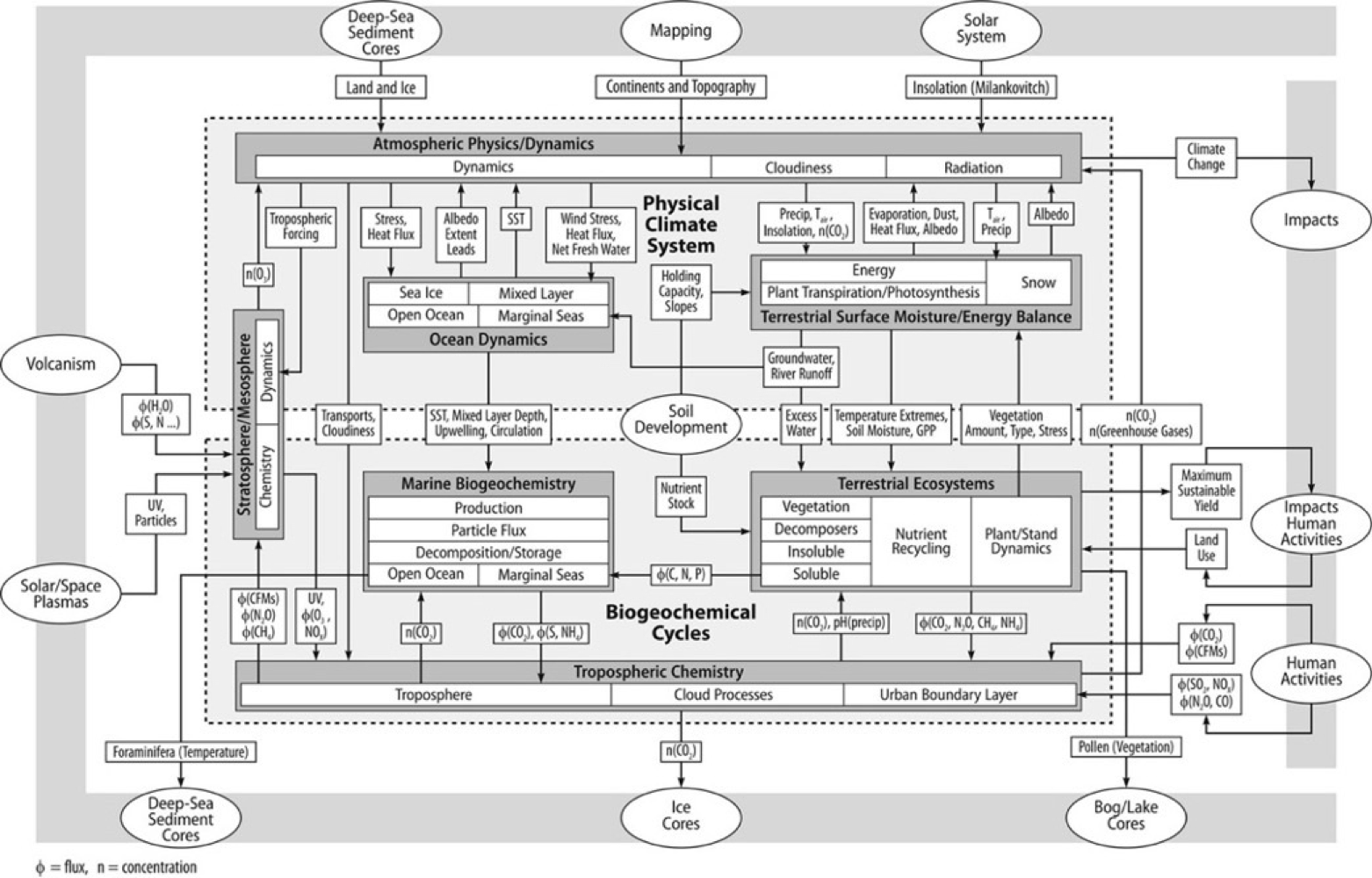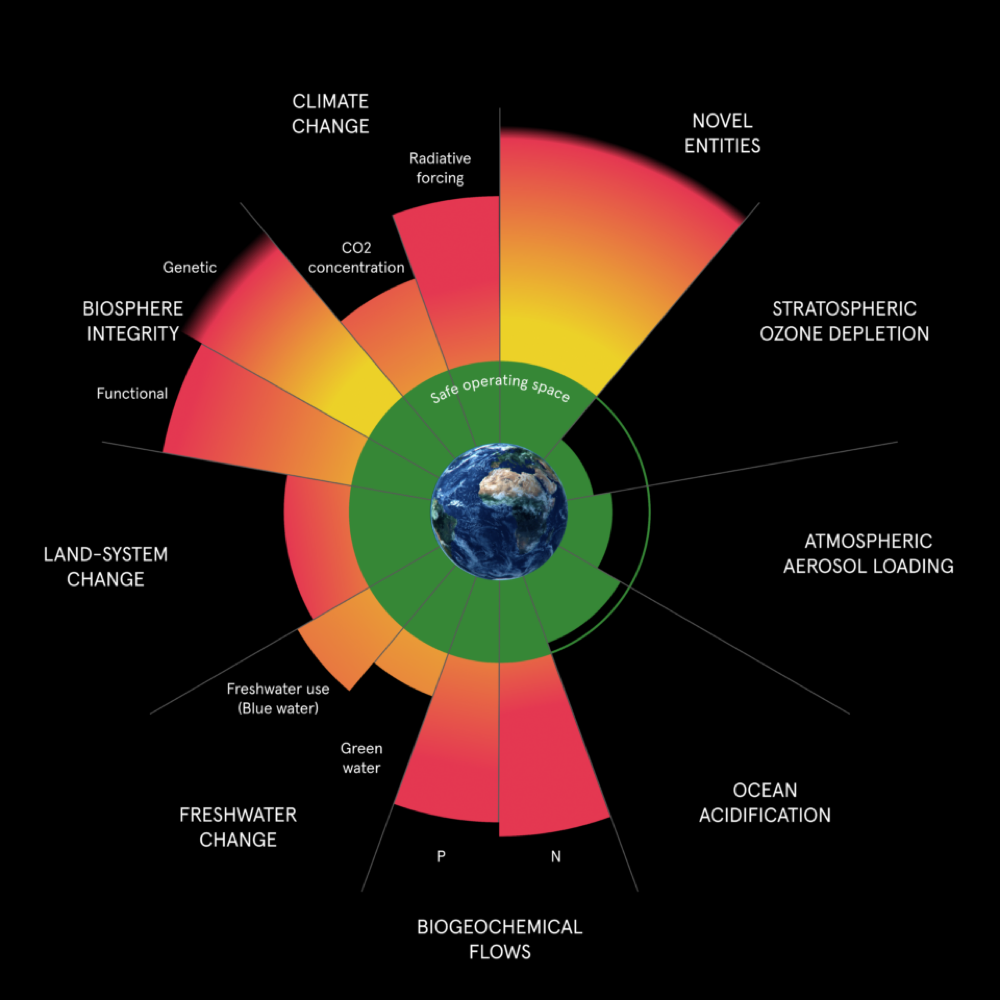The Anthropocene: Key Concepts and Ideas
1/59
Earn XP
Description and Tags
Vocabulary flashcards based on lecture notes about the Anthropocene, including key terms and their definitions.
Name | Mastery | Learn | Test | Matching | Spaced |
|---|
No study sessions yet.
60 Terms
Anthropocene
A proposed geological epoch characterized by significant human impact on Earth's geology and ecosystems.
Geo-graphing
The process of mapping and understanding the impact of human activity on the Earth's geological and ecological systems.
Planetary Boundaries
A framework proposed by geoscientists to define a 'safe operating space' for humanity within Earth's environmental limits.
Eutrophication
A process in which excess nutrients, often from fertilizers, stimulate algal growth in water bodies, leading to oxygen depletion.
GSSP (Global Boundary Stratotype Section and Point)
A formally established geological marker used to designate a specific point in the geological time scale.
Stratigraphy
The branch of geology concerned with the study of rock layers (strata) and layering (stratification).
Holocene
The current geological epoch that began approximately 11,700 years ago, following the last major ice age.
Climate Change
Long-term alterations in temperature, precipitation, wind patterns, and other elements of Earth's climate system.
Nitrogen Cycle
The biogeochemical cycle that describes the transformations of nitrogen and its compounds in the environment.
Feedback Loops
Processes in which a change in a system triggers further changes, which can be either amplifying (positive feedback) or stabilizing (negative feedback).
Describe the Anthropocene and its
significance in geological terms.
The Anthropocene is a proposed geological
epoch that highlights the significant and
lasting impact of human activities on Earth's
geology and ecosystems, suggesting that
humans are a dominant force of nature
Explain how the Anthropocene reflects human
influence on the environment.
The Anthropocene reflects human influence
on the environment by illustrating how
human activities, such as habitat destruction
and pollution, have led to irreversible changes
in Earth's systems.
Define the term 'geo-graphing' in the context
of the Anthropocene.
'Geo-graphing' in the context of the
Anthropocene refers to the unprecedented
degree to which humans are mapping and
altering the Earth's surface and environment,
often with significant consequences.
How has the Covid-19 pandemic exemplified
the concept of the Anthropocene?
The Covid-19 pandemic exemplifies the
Anthropocene by highlighting how human
interactions with nature and environmental
changes can facilitate the emergence of
diseases, showcasing the interconnectedness
of humanity and the planet.
Explain the role of geoscientists in defining
the Anthropocene.
Geoscientists largely control the meaning of
the Anthropocene, focusing on the
unprecedented scale and impact of
humanity's environmental footprint on the
planet
Anthropocene definition
Current geological age where human activity has been the dominant influence
What did Zalasiewicz + Williams say-
“humans dont merely inhabit the world- they alter it on an epic scale”
Covid 19 being an example of the Anthropocene
Facilitated by humans and deepening our relationship with the planet and nature. WHO knew it was just waiting for it to happen. Increased population, nature resilience is weakened. Transmission occurs when we invade the environment. Environmental health and human health are very linked. Good picture to show that this can affect the whole world quickkly. e.g. how fast covid spread.
Stoermer and Crutzen
Created the idea of the Anthropocene, in 2000. They defined the Anthropocene as rhe “centeral role of mankind (SIC), in geology” and by 2025 it has had 551,000 mentions.
Accountability definition
“the giving and demanding of reasons for conduct” (Robert +Scapens, 1985).
What is the IGBP? and what does it do?
The International Geosphere-Biosphere Programme (IGBP) is a global research initiative that aims to study and understand the interactions between the Earth's biological, chemical, and physical systems, focusing on climate change and sustainability. between (1987-2015).
What did Crutzen say in 2002?
Crutzen stated that human activities have become the dominant influence on climate and the environment, marking a new geological epoch.
What is a system
A set of components that operate together in stable ways with a set of more or less stable outcomes e.g. polar ice caps

Holistic concepts include the idea of
Environmental social science
Who has founded the planetary boundaries and the Anthropocene
White, male, middle-class history is often centered around a Eurocentric perspective, highlighting the historical contributions of individuals from these demographics.
Who was Johan Rockstorm
planetary boundaries came about in 2009 mainly geoscientists
What are the 9 planetary boundaries?
climate change, biosphere integrity (functional and genetic), land-system change, freshwater use, biogeochemical flows (nitrogen and phosphorus), ocean acidification, atmospheric aerosol pollution, stratospheric ozone depletion, and release of novel chemicals

Climate change
Already crossed- Ice caps- South peak of Kebnekaise has lost the status of the highest peak- Shrinkning of ½ meter a year for the last 50 years. On a worldwide scale will cause the breaking of the boundary of large glacial melt.
Fundamental for keeping the planet stable- reflection rays from ice caps (Albedo) back into space. 90/95% rays omitted back (GOOD). Shrinking ice caps create a liquid surface which changes the colours and then becomes self-warming- Tipping point reached.
Altitude of ice caps as they melt e..g. Greenland, it gets warmer, causing increased melt. This will only worsen.
Antarctica is also impacted- 50 meters would increase if Antarctica melted- this will impact everything else.
All climate changes occur due to us crossing the boundaries.
Biosphere integrity- Biodiversity loss
Three rainforests, grasslands, wetlands- 1998 experiment in the rainforest- studied how it created its climate- Discovered lots are drying out dry season in the Amazon has extended by 6 days since the 1980s. The ability to recycle water is diminished. Jungle then is replaced by savannah- Savannahisation- Lost 20% of the Amazon so far. Carbon trees also die, causing increasing CO2 emissions. losing 25% risks going further into tipping point- have already destroyed 40%
One million plants and animals out of 8 million are threatened with extinction. 68% of the wildlife population has been kicked off the planet.
1990s short-haired bumble bees are extinct in the UK. Stolen from other countries.
Wild species only make up 4% of the planet's wildlife. The Boundary has been crossed deeply already
Glossy black cockatoos- Australia’s endangered species. Kangaroo Island, Australian wildfires destroyed their habitats.- 2020 Bushfires.
Landsystem change
What it is: Conversion of forests, wetlands, and other ecosystems into agricultural or urban areas.
Why it matters: Reduces biodiversity, disrupts carbon and water cycles.
Fresh water use
Hydrological cyles, humans need 3000 litres per person every day to stay alive. Calculated the runoff level in the water basins to work out the minimum of the tipping point. We are still okay in the zone
What it is: Overuse of freshwater resources (rivers, lakes, aquifers).
Why it matters: Leads to water scarcity, affects agriculture, ecosystems, and human health.
Biogeochemical flows- Nitrogen and phosphorus cycles
Essential components of all living things. Key in fertilizers. affects the fishing. Used to have abundances but now have less. Fertilizers washed into local rivers. E.g., the Baltic Sea- very polluted. Good signal that the planet is weakening. Phosphorus- scientific experiments meant that the food was being grown to keep up with the population, but the excess was used. Eutrophication. Green scum ontop. We are overusing it and deeply affecting the biosphere. This boundary should be taken more seriously.
Ocean acidification
1/3 of co2 emissions go into the oceans- Changes the chemistry. Made it more acidic. When co2 dissolves in water, it creates carbonic acid. 26% more acidic. The acid reacts with carbonate ions, reducing their concentration- Effects skeletons, mass extinctions. This has been seen in the geological records. Unforeseen consequences- Still in the SAFE ZONE currently. looking to a mass extinction currently.- Collapse of coral reefs- Intensity increases due to global warming. Die very quickly. Size of the impact is massive- Great Barrier Reef- Half of these corals have already died.
atmospheric aerosol pollution
Don't know where the boundaries lie yet (Unquantified). Loading of heavy metals, micro plastics, ect. Aerosols are particles in the atmosphere- most from fossil fuel combustion. They cause global dimming. Cutting of sunlight causes cooling and masks the global warming- we don’t know the extent of GHGs. The cooling effect is masking 40% of global warming. Air pollution kills 7 millions per year and takes 3 years of everyines life expectancy. It is expected that we have already crossed it.
What it is: Airborne particles (e.g., soot, dust, sulfates) from pollution.
Why it matters: Affects climate, rainfall patterns, and human health
stratospheric ozone depletion
Only boundary where we are moving in the correct direction- The Discovery of the Ozone hole caused political action to remove the chemicals. Returned to the danger zone, but why can’t we do that now? Ozone intercepts harmful ultraviolet radiation. e.g., skin cancer. The Antarctic ozone hole created a global panic.
release of novel chemicals- chemical pollution
What it is: Introduction of synthetic chemicals, plastics, and genetically modified organisms.
Why it matters: Many have unknown effects on health and ecosystems, and they may persist in nature.
What did Steffen et al say? 2004
“the planet now dominated by Human activites”
“mankind has begun to match and even exceed so of the greatest forces of nature”
stratigraphy defintion
A branch of geology that is concerned with the study of rock layers- reveals stories of physical processes and events as they unfold.
Tell me about the Anthropocene working group in 2009?
Asses evidence of human activity that might eave an enduring stratiographic issue
What do Radionuclides do?
They provide a obvious start date for 1945 and onwards for rock layers
Johan Rockstorm what did he do>
learn what keeps the planet stable- finding the planetary boundaries
What is the Holocene
Period where the temperature stays within ±/- 1 degrees - sea levels stabilize, predictable weather, civilisation was possible. Food was producible- only period that can maintain the humans
why have we entered the Anthropocene
Holocene can no longer look after humans- we are the primary drivers of change- created our own geological epoch. we have converted half of our habitable land to grow crops and livestock. Have more sediment and rocks than any other period- half of the fisheries are acitvely fished
Number of humans that breathe dirty air
9/10 of us breathe dirty air
Tipping point
When a point/ actions goes beyond helping, no going back… Entering a point of no return
what happenned in 1988
Industrial revloution effects kicked in Climate change boundary was crossed.
Only way to reduce climate change-
Reduce co2 usage
What for the future
Cut co2 emissions to stop warming at 2 degrees. We cant emit 40 billion tonnes each year as we will run out in 7 years. Everyone needs to act independently. Pushes the country towards a safe level to calm all levels of the 9 boundaries. We must also reduce the carbon already in the atmosphere by planting trees. AFFORESTATION. Solution to the climate crisis. Eat less meat, veg diet, local sources- Very valuable.
What do trees do?
Trees reduce soil erosion, help the hydrological cycle, and restore the natural world.
Circular economies-
Waste is created by design, bringing in waste from raw materials to make the materials at net 0- making it infinite. Eliminating waste brings us closer to the safe zone. Given us a clear path for ahead.
What do humans gain>
longer life expectancy, cleaner air, and less conflict. We need to put everything aside to focus on a united response to stabilize the planet again.